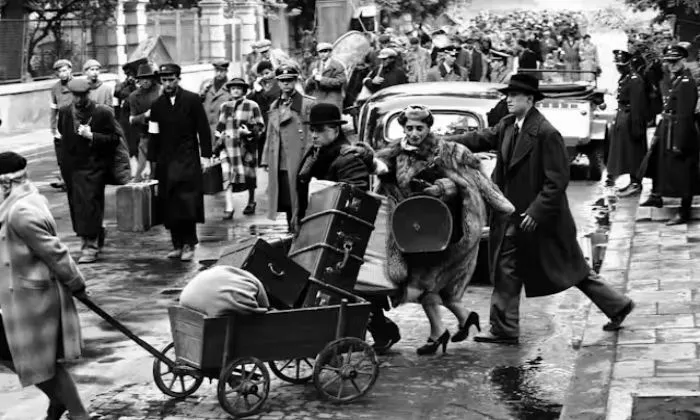Steven Spielberg’s “Schindler’s List” (1993) stands as a transformative and profoundly influential work of cinema, particularly within the context of Holocaust representation in film. Released on December 15, 1993, the film not only garnered critical acclaim and numerous awards but also left an enduring impact on the landscape of Holocaust cinema. As we reflect on the 30th anniversary of “Schindler’s List,” it’s essential to explore how this film changed the course of Holocaust storytelling and continues to resonate as a powerful testament to human resilience, moral courage, and the importance of remembrance.
Setting a New Standard for Authenticity
One of the most significant contributions of “Schindler’s List” to Holocaust cinema was its commitment to authenticity and historical accuracy. Steven Spielberg and his production team conducted extensive research, consulting with Holocaust survivors, historians, and experts to ensure that the film portrayed the experiences of those who lived through the Holocaust with fidelity and respect.
The decision to film in black-and-white added a documentary-like realism to the narrative, evoking the historical photographs and newsreels of the period. This stylistic choice not only heightened the film’s emotional impact but also contributed to its authenticity, immersing viewers in the stark realities of life under Nazi occupation.
Humanizing Holocaust Victims
“Schindler’s List” was instrumental in humanizing Holocaust victims on screen, moving beyond statistical representations to focus on individual stories and personal experiences. Characters like Oskar Schindler, Itzhak Stern, and the Jewish workers in Schindler’s factory were depicted as complex individuals with hopes, fears, and aspirations.
Through intimate portrayals and nuanced performances, the film invited audiences to empathize with the plight of those who suffered during the Holocaust. Spielberg’s emphasis on humanizing the victims challenged prevailing stereotypes and clichés, fostering a deeper understanding of the human cost of genocide.
Confronting Moral Complexity
Central to the narrative of “Schindler’s List” is the exploration of moral complexity and ethical dilemmas in the face of genocide. Oskar Schindler’s character arc, from a self-interested businessman to a compassionate savior, underscores the complexities of individual conscience amid systemic evil.
Spielberg’s nuanced portrayal of Schindler’s transformation invites viewers to confront questions of moral responsibility and complicity. The film challenges the notion of passive bystandership and highlights the importance of taking a stand against injustice, even in the most perilous circumstances.
Educating and Inspiring
“Schindler’s List” has played a pivotal role in educating audiences about the Holocaust and its enduring significance. The film has been widely used as an educational tool in classrooms worldwide, prompting discussions about historical remembrance, moral responsibility, and the consequences of prejudice and hatred.
Spielberg’s commitment to Holocaust education extends beyond the screen. In 1994, he founded the USC Shoah Foundation, dedicated to collecting and preserving testimonies from survivors and witnesses of genocide. The foundation’s work ensures that the voices of those who lived through the Holocaust are preserved for future generations, underscoring the importance of bearing witness to history.
Impact on Holocaust Representation
The release of “Schindler’s List” marked a turning point in Holocaust representation in cinema. Prior to the film, many cinematic depictions of the Holocaust were relatively sparse or sensationalized. Spielberg’s meticulous approach to storytelling and emphasis on historical accuracy raised the bar for filmmakers, challenging them to approach the subject matter with sensitivity and reverence.
In the years following “Schindler’s List,” a new wave of Holocaust films emerged, each grappling with the complexities of memory, trauma, and historical consciousness. Filmmakers like Roman Polanski (“The Pianist”), Agnieszka Holland (“Europa Europa”), and Claude Lanzmann (“Shoah”) contributed to a broader conversation about the ethical responsibilities of representing genocide on screen.
Legacy and Continued Relevance
Thirty years after its release, “Schindler’s List” remains a touchstone in Holocaust cinema, continuing to inspire filmmakers and audiences alike. The film’s impact on popular culture and historical consciousness is profound, serving as a poignant reminder of the enduring imperative to confront history with empathy, remembrance, and moral clarity.
Conclusion
As we commemorate the 30th anniversary of “Schindler’s List,” we honor Steven Spielberg’s visionary contribution to Holocaust representation and celebrate the enduring legacy of a film that changed the course of cinema. Through its uncompromising storytelling and profound emotional resonance, “Schindler’s List” continues to remind us of the importance of bearing witness to history and upholding the values of compassion and justice in the face of unspeakable evil.
In conclusion, “Schindler’s List” stands as a testament to the transformative power of cinema to educate, inspire, and provoke reflection. By humanizing Holocaust victims, confronting moral complexity, and fostering a deeper understanding of historical trauma, Steven Spielberg’s film has left an indelible mark on Holocaust cinema and continues to resonate as a timeless masterpiece.
Related Topics:
Understanding the Main Point of “Schindler’s List”
The Symbolism of the Girl in the Red Coat in “Schindler’s List”
Ralph Fiennes: Portraying a New Kind of Evil in “Schindler’s List”

